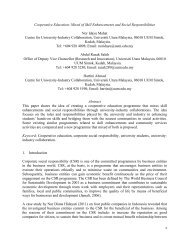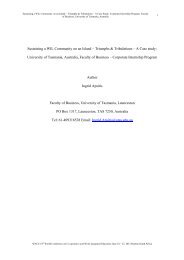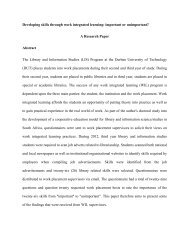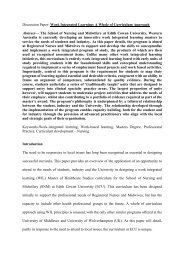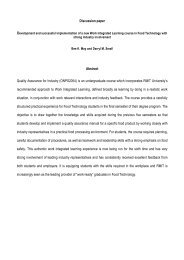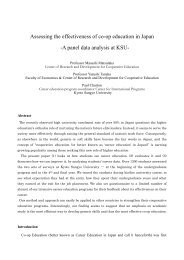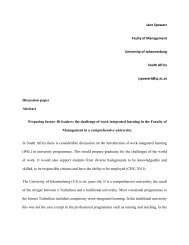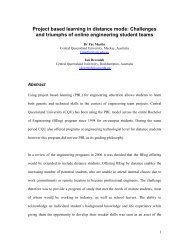Susanne Taylor & Cookie Govender, University of ... - WACE
Susanne Taylor & Cookie Govender, University of ... - WACE
Susanne Taylor & Cookie Govender, University of ... - WACE
Create successful ePaper yourself
Turn your PDF publications into a flip-book with our unique Google optimized e-Paper software.
<strong>WACE</strong> International Conference 2013Towards a work integrated learning partnership model for higher education and industry -a Human Resource Management pilot projectAbstractAccording to South Africa’s National Development Plan: Vision for 2030 (SA, 2011a), the aimis to reduce the current unemployment rate in South Africa from 27 percent in 2011 to 6 percentby 2030. Education, training and skills development initiatives, especially at higher educationinstitutions (HEIs), are a key aspect to the success <strong>of</strong> this endeavour.The Faculty <strong>of</strong> Management at the <strong>University</strong> <strong>of</strong> Johannesburg aims to create ‘future fit leaders’so that graduates who enter the workplace are equipped with the required management andleadership skills, attitudes, values and knowledge.Leading from this aim, a work integratedlearning (WIL) partnership model is being piloted to bridge the gap between theoretical lecturesand practical industry experience for final year Human Resources Management (HRM) Diplomastudents, whose programme has not previously contained a WIL component.The WIL partnership model seeks to fast-track industry partner identification, cement suchpartnerships and allocates individual or groups <strong>of</strong> students to these approved industry partnersfor mentoring, work shadowing and project–based workplace learning. The model is intended to
e a viable, cost-effective and practical solution for large numbers <strong>of</strong> students to gain workplaceexperience, thus aligning lectures to workplace policy, procedures and practices.This paper presents an overview <strong>of</strong> WIL in South African higher education institutions (HEIs),the country’s skills development legislation and the changes in the educational landscape. Thepilot model, its various phases, the implementation process and the anticipated impact arepresented for discussion.The aim <strong>of</strong> this paper is to stimulate discussion on the pilot WIL partnership model as a norm forother HRM qualifications <strong>of</strong>fered by the faculty, as well as in other HEIs. This paper adds valueon a strategic, theoretical and practical level. The proposed WIL partnership model promotes theobjective <strong>of</strong> the country’s Vision for 2030 by creating employable graduates who may beabsorbed into mainstream employment by some <strong>of</strong> the industry partners.IntroductionInternational trends reveal that work integrated learning (WIL) with examples <strong>of</strong> industrypartnership projects in higher education institutions (HEIs) are on the increase. It is an acceptedfact that classroom-based instruction alone does not produce future-fit graduates. The role <strong>of</strong>WIL or learning for performance is essential in the development <strong>of</strong> the desired graduate pr<strong>of</strong>ile.The competency pr<strong>of</strong>ile <strong>of</strong> a graduate should include discipline specific knowledge, skills andattitudes, as well as generic cognitive, behavioural and technical skills and attributes (Coll &Zegwaard, 2006; Powell, Tindal & Millwood, 2008; Ishisaka, Farwell, Song, & Uehara, 2004).
In South Africa (SA), WIL or work-based learning is also being increasingly utilised withinHEIs. While there are definite academic, personal, career and work ethic benefits, WIL promotespartnerships with business, industry and government to improve economic growth for thecountry (Matoti, Junqueira & Odora, 2011). Nearly 70% <strong>of</strong> SA’s population <strong>of</strong> 50 million peopleare under the age <strong>of</strong> 35. Many <strong>of</strong> these young people are either semi-skilled, unemployed or arein the process <strong>of</strong> entering the economic sector. Over 11 million employment opportunities arerequired to reduce South Africa’s unemployment rate from 27 percent in 2011 to 6 percent by2030 (SA, 2011a). With the latest <strong>of</strong>ficial unemployment rate <strong>of</strong> 25.2% (Stats SA, May 2012)education, training and skills development is high on the national agenda.The higher education landscape in SA has changed radically since 2004, creating the <strong>University</strong><strong>of</strong> Johannesburg (UJ) through a merger process in 2005. The <strong>University</strong> supports a ‘learning tobe’ teaching and learning strategy, particularly embraced by the Faculty <strong>of</strong> Management thataims to produce ‘future fit leaders’ <strong>of</strong> all its graduates. Within this faculty, the department <strong>of</strong>Industrial Psychology and People Management (IPPM) <strong>of</strong>fers a variety <strong>of</strong> qualifications in theHuman Resources Management (HRM) programme, from Diploma to postgraduate Doctorates.In order to bridge the gap between theoretical lectures and practical industry experience for allstudents, ideally, a WIL component is required for all qualifications, which is currently not inplace. This discussion paper presents a proposed WIL partnership model for pilotimplementation in the HRM Diploma qualification. The model aims to ensure that graduates whoenter the workplace are equipped with the basic HRM skills, attitudes, values and knowledge and
are ready for easy transition into a formal workplace as HR Practitioners and Pr<strong>of</strong>essionals (DeVos, 1998).The aim <strong>of</strong> this paper is to introduce the WIL partnership model that may become the norm forother qualifications <strong>of</strong>fered by the Faculty, as well as in other HEIs. Furthermore, it is anticipatedthat this WIL model will directly impact South Africa’s Vision for 2030 by reducingunemployment through increasing the graduate chances <strong>of</strong> employability, with the added benefitthat some graduates may be absorbed into mainstream employment within some <strong>of</strong> the industrypartners.As background to the model design, an overview <strong>of</strong> work integrated learning, education in SouthAfrican HEIs, the country’s skills development legislation and the changes in the educationlandscape are investigated and presented below. Thereafter, the proposed WIL partnershipmodel, its various phases, the implementation process and its anticipated impact are presentedfor discussion.Work integrated learning (WIL): a theoretical framework based on experiential educationThe beginnings <strong>of</strong> experiential education may be attributed to Confucius (450 BC), who said“Tell me, and I will forget. Show me, and I may remember. Involve me, and I will understand.”Since this time, various theories/theoretical frameworks have evolved, concepts have beenformulated and various terms have been coined in the field <strong>of</strong> experiential education.
A snapshot <strong>of</strong> some <strong>of</strong> the main experiential education theoretical frameworks are: Dewey’sformula: Experience + Reflection = Learning (Dewey, 1938); David Kolb’s (with Roger Fry)experiential learning cycle (Kolb, 1984); the action research model developed by Kurt Lewin,who is seen as the ‘father’ <strong>of</strong> action research (Reason & Bradbury, 2001) the model <strong>of</strong> reflectiveenquiry and observation as proposed by John Dewey, David Boud and Donald Schön (Schön,1983); and more recently the CLARION model to highlight the role <strong>of</strong> implicit and explicitlearning (Sun & Zhang, 2004; Sun, Zhang, Slusarz & Mathews, 2007).Experiential learning or WIL involves the placement <strong>of</strong> students into workplace settings to moveindividuals from being just students to becoming novice pr<strong>of</strong>essionals. Work placements areaccepted as part <strong>of</strong> academic curricula in the rapidly changing practice-orientated HEI landscapethat is different to traditional courses. Significant theoretical questions arise from WIL curriculasuch as: how do students make sense <strong>of</strong> work experiences; how to turn work procedural learninginto assessment forms; is self-regulation and self-authorship promoted by portfolio assessment?(Bates, 2003; Meeus, Looy & Libotton, 2004).SA’s Higher Education Quality Council defines WIL as:Work Integrated Learning (WIL) is the component <strong>of</strong> a learning programme that focuseson the application <strong>of</strong> learning in an authentic learning workplace context under thesupervision and/or mentorship <strong>of</strong> a person/s representing the workplace. It addressesspecific competencies identified for the acquisition <strong>of</strong> a qualification that make thelearner employable and assists in the development <strong>of</strong> related personal attributes.Workplace/service employees and pr<strong>of</strong>essional bodies are involved in the assessment <strong>of</strong>
the learning experience, together with <strong>University</strong> academic employees (Higher EducationQuality Committee, 2004).The Council for Higher Education publication Work-Integrated Learning: Good Practice Guide(2011: 16-21) outlines four main curricular modalities for programmes, especially new modelsin SA that align workplace experience (practical) and academic interests (theory) as follows:work-directed theoretical learning (WDTL); problem-based learning (PBL); project-basedlearning (PjBL); and workplace learning (WPL). The latter, WPL, is commonly referred to asWIL in the South African context (SATN, 2008).The higher education landscape and legislation in SAThe higher education landscape in SA has undergone many changes, specifically since 2004,with the merger <strong>of</strong> several <strong>of</strong> the public HEIs. In 2009, the 25 HEIs, the 50 public FurtherEducation and Training colleges (in addition to numerous private training providers) and the 21Sector Education and Training Authorities (SETAs) were placed under a newly formed Ministry<strong>of</strong> Higher Education and Training (SA, 2009), consolidating the post school education andtraining sector under one government ministry.The SETAs that had been established with the introduction <strong>of</strong> the skills development legislationin 1998 to disburse skills levy funds to organisations and promote workplace training withinspecific economic sectors <strong>of</strong> SA, were previously located with the Department <strong>of</strong> Labour. In asignificant shifting <strong>of</strong> the SA education, training and skills development landscape, higher
education and skills development were merged into a single ministry, further signalling thecountry’s commitment to economic, human resources and national development.In 2007, SA’s eight-level National Qualifications Framework (NQF) structure was modified tobecome a ten-level Higher Education Qualifications Framework (HEQF). This revisedqualifications framework necessitates re-evaluation and redesign <strong>of</strong> programmes to align withthe new framework (SA, 2007). One <strong>of</strong> the recurriculation objectives is to ensure that revisedqualifications allow graduates to meet the world <strong>of</strong> work expectations, thus improvingemployability. The changing SA landscape, especially that <strong>of</strong> higher education, provides aconducive climate to introduce and pilot a workplace learning innovation with the HRMDiploma, third year students.Labour and skills development in SAA key aspect <strong>of</strong> the National Development Plan (SA, 2011a) is sustainable development for SA,with government, business and civil society initiatives to improve the lives <strong>of</strong> all South Africans.This, together with other recent skills development and human resource legislation promulgated,such as the National Skills Development Strategy III (2011c), the National Skills Accord(2011b), the Skills Development Amendment Bill (2011d) and the Green Paper for Post-SchoolEducation and Training (2012) gave impetus to this proposed model. A recurring theme acrossthe legislation is the concept <strong>of</strong> academic and industry partnerships, specifically the triple helixpartnerships: education, government and industry.
SA is known for its stringent labour laws. The stipulations <strong>of</strong> the Labour Relations Act (SA,1995) makes a dismissal process costly as well as lengthy, making it imperative thatorganisations hire the right staff. The model proposed takes cognisance <strong>of</strong> this important aspectand will afford organisations an opportunity to evaluate a student in the actual workplace for atime period, rather than simply making a hiring decision based on an interview process.Proposed WIL Partnership ModelThis conceptual paper proposes a theoretical WIL partnership model designed to develop apartner company base (one which currently does not exist for the HRD programme) and toallocate students to approved partner organisations for mentoring, work shadowing and project–based workplace learning. The model entails a viable, cost-effective and practical solution forlarge numbers <strong>of</strong> students to gain workplace experience, thus bridging the gap between thelecture hall and workplace practices.A key feature <strong>of</strong> the WIL partnership model is theestablishment <strong>of</strong> an extensive industry partner base for innovative student placement in themarketplace so that there is maximum benefit for student, industry and training provider. Tostreamline the placement <strong>of</strong> the many students in the programme (150+) the ultimate aim <strong>of</strong> themodel is to allocate groups <strong>of</strong> students (7-10) to a pool <strong>of</strong> approved companies with whom amemorandum <strong>of</strong> agreement in this regard will be concluded. These partner companies wouldthen also be invited to make presentations on HR relevant topics to the total group <strong>of</strong> students,thus further promoting their company as an employer <strong>of</strong> choice to the student cohort.
The WIL partnership model is a framework consisting <strong>of</strong> five phases implemented over a period<strong>of</strong> 10-12 months as follows: design, develop and approval; preparation; implementation;evaluation; and review phases. Each phase has 4-5 processes that require essential resources.Phase 1: Design, development and approval <strong>of</strong> the WIL model, involves the following fiveprocesses: adopt or design the WIL model; identify students and industry partners; consult withstakeholders for approval, support and review; develop the supporting documentation andcommunicate the details <strong>of</strong> the WIL project plan. The essential resources required for Phase 1include a WIL project team; students and industry partners; faculty committees, departmentalteams, members and lecturer; and communication information such as learning guides withspecific outcomes (SOs), assessment criteria (ACs), time span <strong>of</strong> WIL component and weighting<strong>of</strong> marks, as well as letters <strong>of</strong> introduction to the company, pro forma Memorandums <strong>of</strong>Understanding and a PowerPoint presentations.Phase 2: Preparation to implement the WIL model, considers the following four processes:conduct awareness and information sessions to prepare the stakeholders for the WIL project;distribute WIL information packs; prepare students for entry into the workplace and finalise theindustry partnership base. The essential resources required for Phase 2 are: selected students;relevant lecturer; WIL project team; academic support services for students; selected industrypartners; information packs <strong>of</strong> memos, letters, brochures, portfolio <strong>of</strong> evidence (PoE) criteria andrelevant forms.; pre-planned workplace readiness workshops to empower students on job search,CV writing, interview skills, dress code, business etiquette and the necessity <strong>of</strong> acquiring taxnumbers and bank accounts.
Phase 3 <strong>of</strong> the WIL partnership model is the implementation phase. It incorporates the aspectsindicated below: confirmation <strong>of</strong> placement list; indemnity and risk management; support basefor students and partners communicated; tracking and feedback from students and supervisors.The resources required for Phase 3 are: signed letters from industry partners (supervisor/ mentor)per student; established data base <strong>of</strong> industry partners; indemnity forms and safety insurance forHEI and industry partners; structured PoE with progress reports, attendance and performancetasks, challenges experienced, competencies displayed and employability growth reflections inPoE/ reflective reports.Phase 4: Evaluation <strong>of</strong> the WIL model requires the processes <strong>of</strong> gaining feedback from thelecturer; student; industry partners; and evaluation, recognition and appreciation <strong>of</strong> the industrypartners and stakeholders. The essential resources required during this phase are lecturerassessment ratings <strong>of</strong> student POEs as per the assessment criteria; quantitative and qualitativeresearch data from students and industry partners; the hosting <strong>of</strong> award ceremonies toacknowledge the participating industry partners and other stakeholders.Phase 5 <strong>of</strong> the proposed WIL partnership model, the review phase, concludes the frameworkwith processes that focus on questions and solutions for improving the model design as follows:what worked; what did not work; what should change; and how best to revise and improve themodel. The essential resources for this phase are: WIL project team report on the strengths,weakness, opportunities and threats <strong>of</strong> the WIL partnership model; risk management strategies;stakeholder consultation; and an improved WIL partnership model.
Implications for WIL Partnership ModelThis paper reports on exploratory, theoretical research towards the development <strong>of</strong> a WILpartnership model involving approved industry partners who will mentor students they haveselected to gain experiential, practical workplace learning to complement classroom lectures.The model proposes that all students undergo work preparedness lectures to empower them withwinning CV and interview skills. Learning guides, letters, memoranda, forms and documentsform the basis <strong>of</strong> the communication strategy to stakeholders. Surveys prior to and after theimplementation phase will be introduced to measure the impact <strong>of</strong> the WIL model. The aim <strong>of</strong>the model is to promote HEI and industry partnerships to make a difference in the employability<strong>of</strong> graduates that exit HEI qualifications.In the pilot phase, students will spend 40 hours (one week) in the workplace during a universityrecess to experience the practical implications <strong>of</strong> their theoretical knowledge, thereby enhancingand broadening it. The WIL partnership model anticipates that students will develop in their field<strong>of</strong> study with the potential for absorption into the workplace after graduation. Simultaneously,industry partners are able to evaluate potential employees when students interact with themduring the WIL placement opportunity. Furthermore, the HEI, faculty, department and WILproject team members gain the benefits <strong>of</strong> meeting national and international obligations forintegrating theory and practice in learning programmes. Inviting industry into the classroom andcreating an opportunity for lecturers to interact with current workplace practices can onlyimprove learning programmes. The development <strong>of</strong> a sustainable approved set <strong>of</strong> industry
partners is a crucial aspect <strong>of</strong> this model, given that once it has been integrated into the HRMprogramme, it will be a compulsory component with attached credit values. Companies will beapproved according to the university’s guidelines, the WIL will be integrated into the curriculumthus making it unnecessary to utilise the recess period and companies may well provide stipendsto the students, which is not an expectation in the pilot phase. A costing for the WIL model willbe prepared to assist in the budgeting process, to ensure that all the partnership building,documentation and feedback mechanisms are enabled.ConclusionPartnership development and utilizing work integrated learning as a means not only to entrenchconcepts taught in the classroom but also for gaining both work experience and entrance into apermanent workplace is a key imperative for the WIL partnership model proposed. This paperinvites discussion <strong>of</strong> the proposed WIL partnership model that will be piloted with the HRMDiploma third year students in the IPPM department <strong>of</strong> the Faculty <strong>of</strong> Management within the<strong>University</strong> <strong>of</strong> Johannesburg. It is recommended that rigorous research be undertaken to measurethe impact <strong>of</strong> the proposed WIL partnership model in the pilot project. It is hoped that thismodel (together with the developed support material) may be replicated, thus opening doors forother programmes to introduce WIL components. Thus, education and industry working inpartnership to close the skills gap and to effect drop in the unemployment rate.References
Bates, M. (2003). The assessment <strong>of</strong> work integrated learning: symptoms <strong>of</strong> personal change.Journal <strong>of</strong> Criminal Justice Education 14(2).Coll, R. K., & Zegwaard, K. E., Perceptions <strong>of</strong> desirable graduate competencies for science andtechnology new graduates. Research in Science & technological Education. 20(1), 29-58.Council for Higher Education. (2011). Work-Integrated Learning:Good Practice Guide.Pretoria: IeCommunications.De Vos, A. S. (1998). (ed). Research at Grass Roots. A Primer for the Caring Pr<strong>of</strong>essions. VanSchaick Publishers. Pretoria.Dewey, J. (1938). Experience and Education. Macmillan.Higher Education Quality Committee (2004). Institutional Audit Criteria. Pretoria:Council for Higher Education.Ishisaka, H., Farwell, N.E., Song, S. S. L., & Uehara, E. S. (2004). Teaching Notes, Partnershipfor Integrated community-based learning: A social work community-campuscollaboration. Journal <strong>of</strong> Social Work Education 40(2).Kolb, D. A. (1984). Experiential Learning. Engelwood Cliffs, NJ: Prentice Hall.Matoti, N., Junqueira, E. K., Odora, R. J. (2011). A comparative study <strong>of</strong> pre-service teachers’self-efficacy beliefs before and after work integrated learning. SAJHE 25(6), 1140-1177.Meeus, W., Looy, L. V., & Libotton, A. (2004). The Bachelor’s thesis in teacher education.European Journal <strong>of</strong> Teacher Education 27(3).Powell, S., Tindal I., & Millwood, R. (2008). Personalized Learning and the Ultraversityexperience. Interactive Learning environments 16(1), 63-81.Reason, P. & Bradbury, H. (2001). Eds. Handbook <strong>of</strong> action research. Participative inquiry andpractice. Sage. London.
SATN. (2008). Position paper on work-integrated learning (WIL) in the new HEQF. SouthAfrican Technology Network.Schön, D. (1983). The reflective practitioner. Basic Books: New York.South Africa. (1995). Labour Relations Act (Act 66 <strong>of</strong> 1995). Pretoria: GovernmentPrinter.South Africa. (2007). Higher Education Qualifications Framework. Pretoria:Government Printer.South Africa. (2009). Proclamation No 56 <strong>of</strong> 2009. Government Printer: Pretoria.South Africa. (2011a). National Development Plan: Vision for 2030. Pretoria:Government Printer.South Africa. (2011b). National Skills Accord. Pretoria: Government Printer.South Africa. (2011c). National Skills Development Strategy III (2011-2016).Pretoria:Government Printer.South Africa. (2011d). Skills Development Amendment Bill. Pretoria: GovernmentPrinter.South Africa. (2012). Green Paper for Post-School Education and Training. Pretoria:Government Printer.Stats SA. (2012). Unemployment rises to 25.2%. SAnews.gov.za, 8 May 2012. Statistics SA:Pretoria.Sun, R. & Zhang, X. (2004). Top-down versus bottom-up learning in cognitive skill acquisition.Cognitive systems research 5, 63-89.
Sun, R., Zhang, X., Slusarz, P. & Mathews, R. (2007). The interaction <strong>of</strong> implicit learning,explicit hypothesis testing and implicit-to-explicit knowledge extraction. NeuralNetworks 20, 34-47.



